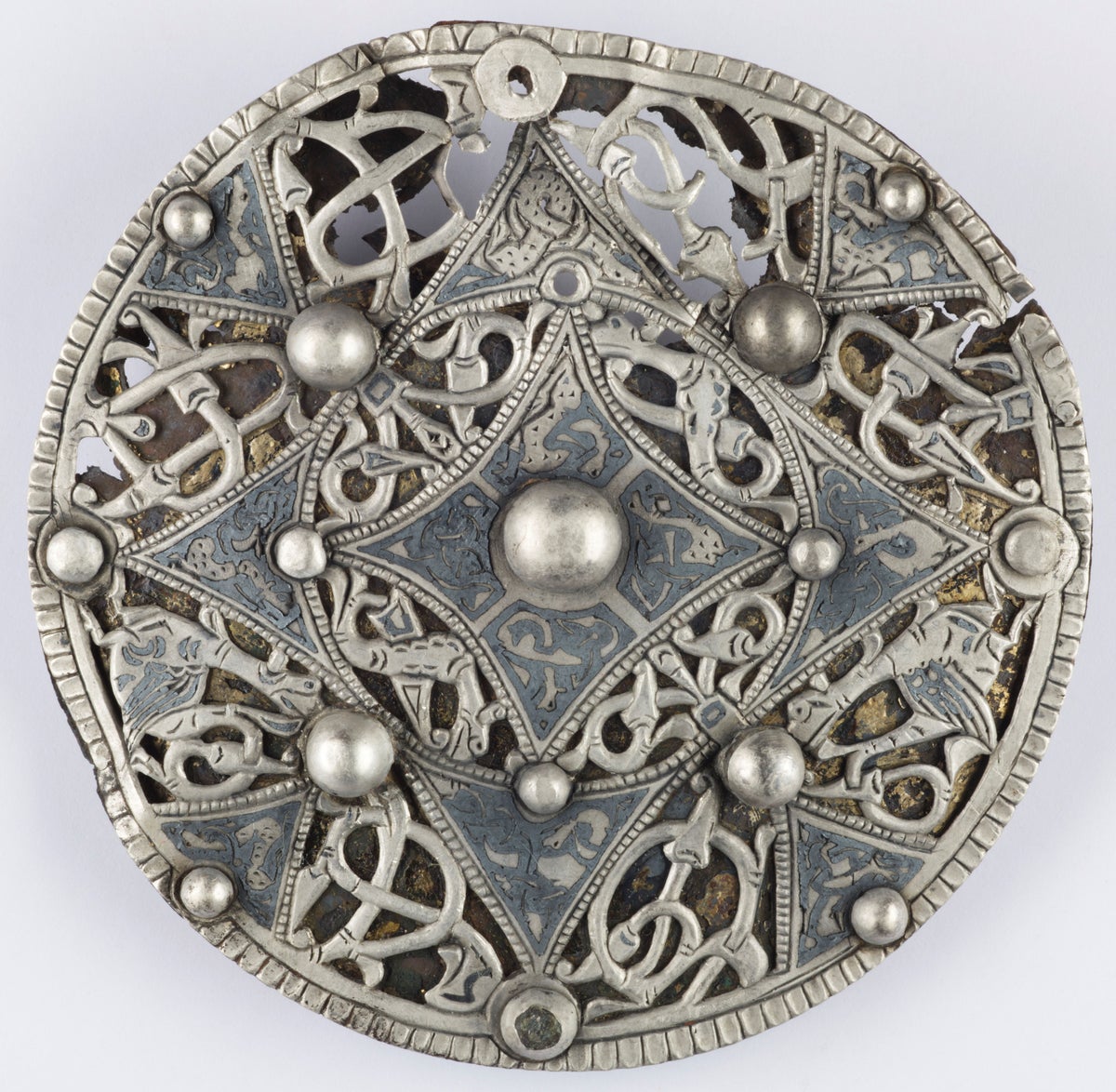
A mysterious piece of early medieval jewellery found by metal detectorists in Somerset could have royal origins, experts believe.
The huge nine-centimetre diameter silver and bronze brooch, one of the largest such objects ever found, was unearthed by a metal detectorist on the edge of former marshland between Cheddar and Wedmore - two locations associated with Anglo-Saxon royalty.
Experts believe the brooch may be linked to the household of Alfred the Great or one of the other Anglo-Saxon kings of England.
The brooch itself was finely decorated with mythological beasts, including a rare portrayal of a pair of two-legged dragons, known as wyverns, a mythological animal specifically linked with the Anglo-Saxon royal dynasty, associated with both Cheddar and Wedmore.
A portrayal of what an Anglo-Saxon king and his witan ('parliament'), meeting at Cheddar, might have looked like - from the 11th century Old English Hexateuch in the British Library. They are all wearing circular brooches, but nothing as big as the recently-discovered Cheddar Brooch— (David Keys)
Dragons - in some cases specifically wyvern-style ones - were used by the Anglo-Saxon kings of Wessex, who built important royal centres at Cheddar and Wedmore, as insignia on battle flags. Indeed at the Battle of Hastings, King Harold (King of Wessex and England) fought under a wyvern standard. Wyverns symbolised power, conquest and strength.
At the time that the giant brooch was likely lost, Cheddar was one of the most important places in Wessex. An Anglo-Saxon palace was constructed there in the 9th century and became a royal hunting lodge. Alfred the Great was particularly associated with it and several Anglo-Saxon ‘parliaments’ were even held there.
Just four and a half miles from Cheddar, Wedmore was also an Anglo-Saxon royal site with an important royal hunting lodge and was also much associated with Alfred the Great, who celebrated there after he had defeated the Vikings.
The circumstances in which the brooch was lost are unknown. However, the find-spot seems to have attracted human activity on a number of occasions between the 9th and 11th centuries.
For, as well as the giant silver brooch lost there in the 9th century, the location also seems likely to have later been used as an outdoor feasting site. The remnants of at least one such event - including around a dozen shards of pottery and a similar number of burned animal bones - have been found by archaeologists.
King Alfred the Great was closely associated with Cheddar, the area where the giant silver brooch was found. This silver coin showing the king is in the British Museum.— (David Keys)
The area was associated with Anglo-Saxon royal hunting activity, so it is conceivable that the brooch was lost during a royal hunt or hunt-related feast by an Anglo-Saxon royal or a high-status courtier.
Scientists and art historians have been studying and conserving the object for the past two years and archaeologists have excavated the find site.
The wyvern (a two-legged dragon) was a symbol of the Anglo-Saxon Kings of Wessex/England - and features on the giant silver brooch. This image, from the Bayeux Tapestry, shows the last ruler of Wessex's wyvern banner at the Battle of Hastings.— (David Keys)
The brooch is scheduled to go on public display for the first time later this month at the Museum of Somerset in Taunton.
Curator of Archaeology, Amal Khreisheh, said: “Conservation has transformed this fascinating brooch and revealed the intricacies of its design. The fascinating details uncovered include fine scratches on the reverse which may have helped the maker to map out the design.
“A tiny contemporary mend on the beaded border suggests that the brooch was cherished by its owner and worn for an extended period of time before it was lost”.
Tom Mayberry, Chief Executive of the South West Heritage Trust said: “In 878 Alfred the Great rallied his forces in Somerset and defeated the invading Danish army. Wessex was secure and the foundations had been laid for the creation of a unified English kingdom.
“The Cheddar Brooch comes from a time that was a turning point in English history.”
The brooch was found by Iain Sansome while metal-detecting on farmland near Cheddar, Somerset.
He reported it through the Portable Antiquities Scheme via the scheme’s local Finds Liaison Officer, who with the South West Heritage Trust organised a follow-up archaeological excavation of the find-spot.
The brooch has now been acquired by the Museum of Somerset, under the Treasure Act, with support from the Arts Council England/V&A Purchase Grant Fund, the Art Fund and the Friends of the Museum of Somerset.







